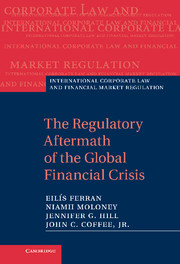Book contents
- Frontmatter
- Contents
- Foreword
- Notes on Contributors
- Acknowledgements
- Table of cases
- Table of legislation
- 1 Crisis-driven regulatory reform: where in the world is the EU going?*
- 2 The legacy effects of the financial crisis on regulatory design in the EU
- 3 Why did Australia fare so well in the global financial crisis?
- 4 The political economy of Dodd-Frank: Why financial reform tends to be frustrated and systemic risk perpetuated
- Index
- References
1 - Crisis-driven regulatory reform: where in the world is the EU going?*
Published online by Cambridge University Press: 05 December 2012
- Frontmatter
- Contents
- Foreword
- Notes on Contributors
- Acknowledgements
- Table of cases
- Table of legislation
- 1 Crisis-driven regulatory reform: where in the world is the EU going?*
- 2 The legacy effects of the financial crisis on regulatory design in the EU
- 3 Why did Australia fare so well in the global financial crisis?
- 4 The political economy of Dodd-Frank: Why financial reform tends to be frustrated and systemic risk perpetuated
- Index
- References
Summary
Introduction
Never waste several good crises . . .
On the surface at least, crises shake the status quo and provide space for new ideas to emerge. Complacent assumptions are overturned, policy learning takes place and there is a sharpened focus on the concerns that demand a robust response. The issues acquire the degree of political salience that is needed to push through a reform agenda.
The international regulatory response to the global financial crisis of 2007–9 appears to support the idea of crisis as a game-changer. The world's leading economies have adopted an apparently ambitious agenda for international financial regulation and have put in place institutional changes designed to bolster implementation of international standards and to reinforce surveillance. They have also been putting in place far-reaching reforms at national or regional level. The United States has passed a mammoth piece of legislation with a view to reforming Wall Street and reinvigorating financial regulation. The European Union (EU) is being no less determined in the extent of its reform program, although it is proceeding on a measure-by-measure basis rather than attempting to deal with everything in a single instrument. A common feature of the reforms on both sides of the Atlantic is that implementation is dependent on the adoption of a large number of detailed rules, many of which are still under development at the time of writing (Spring 2012). The level of government intervention in markets that is involved in these financial reform packages is far removed from mainstream policy preferences of just a few years ago. On the European side, moreover, the pace of both coordination between Member States and centralization at EU level has accelerated. Spillover effects from the reforms that are eventually put in place to resolve the euro area sovereign debt crisis could lead to a still further concentration of EU regulatory power with respect to the financial markets. Since an effective solution to the euro area crisis remains elusive at the time of writing, the possibility that the reforms that are eventually adopted could reverse the trend by triggering a reining in of EU regulatory authority and perhaps even a “repatriation” of powers to Member States must be acknowledged. However, this appears to be a less likely outcome than an expansion and reinforcement of the existing tendencies.
- Type
- Chapter
- Information
- The Regulatory Aftermath of the Global Financial Crisis , pp. 1 - 110Publisher: Cambridge University PressPrint publication year: 2012
References
- 6
- Cited by

